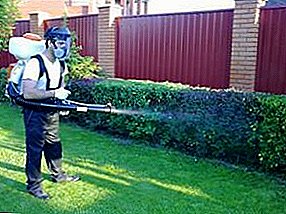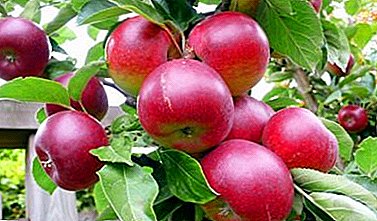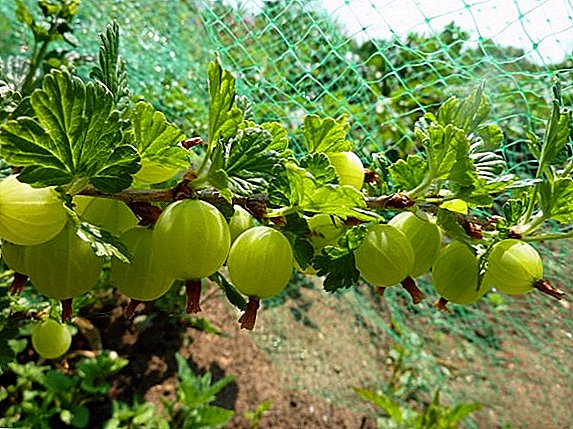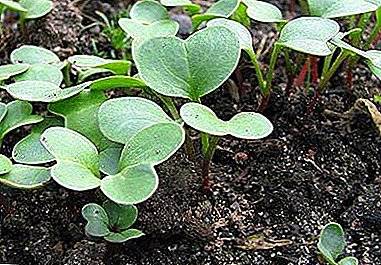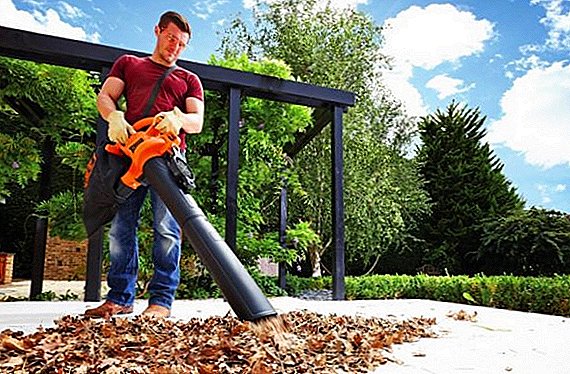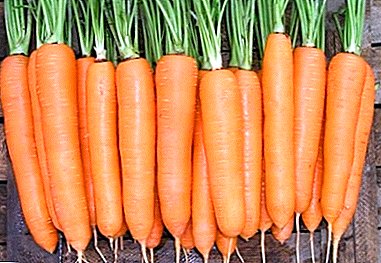
Dordogne is a new hybrid variety of carrots, which has already gained popularity due to its high yield, excellent keeping quality and good presentation.
This article will discuss the distinctive features, advantages and disadvantages of this hybrid, as well as the peculiarities of its cultivation and harvest.
You will learn how to choose a place for planting and prepare the soil, how planting, watering and feeding are carried out, as well as what possible problems in growing can arise and how to solve them.
Description and characteristics

- Appearance. Dordogne carrots have smooth, blunt root vegetables of bright orange color, the large core, which is weakly expressed, does not stand out strongly on the pulp. Root length - 15-30cm, diameter - 4-6cm. Rosette of leaves semi-sprawling, tops of dark green color.
- What sort is it? Dordogne - a variety of Dutch breeding, belongs to the Nantes variety.
- Fructose and beta-carotene content. The content of beta-carotene in carrots - about 12%, fructose and other sugars - 7%.
- Sowing time. Sowing time depends on your region. In the southern regions and central latitudes, Dordogne carrots are planted in early to mid-April, in the northern regions - in May.
- Seed germination. A distinctive feature of the variety are smooth, amicable shoots.
- Average weight The average weight of a root Dordogne can vary from 70 to 120g.
- Productivity The yield of the variety is 3.5-7.2 kg per square meter.
- Assignment grade and keeping quality. This hybrid is well stored, with the right storage conditions, roots can last 8-9 months, maximum 10.
Carrots of this variety are ideal for making juices and mashed potatoes, its pulp is not fibrous, sweet and very juicy.
- Growing regions. The variety is universal, it is suitable for cultivation in all regions, up to the Far North.
- Where it is recommended to grow. Dordogne can be grown both in the greenhouse and in the open field.
- Resistance to diseases and pests. Like all hybrids, Dordogne is resistant to diseases and pests, infection occurs very rarely, its cause is mainly improper care (see below).
- Maturation term. This variety is mid-season - root crops reach technical maturation in 110 days.
- What kind of soil does it prefer? This carrot can be grown on all soils, but the best result can be obtained on light sandy soils. It is better not to use soil with high acidity for growing carrots. Heavy stony soil is also not suitable.
- Frost resistance. It is characterized by resistance to temperature changes, it tolerates heat and cold well.
- Manufacturability varieties for farms and farms. This hybrid is ideal for growing for sale, therefore it is particularly popular with farmers - in addition to high yields, excellent keeping quality and good taste, it has high marketability and is not subject to mechanical damage, which makes it suitable for mechanized harvesting.
Photo carrot varieties Dordogne:



Breeding history
The hybrid variety was bred by Dutch breeders of Syngenta Seeds. It was included in the Russian State Register in 2007, in the same year it was zoned and recommended for cultivation in the northern regions.
Distinctive features
The main features of the Dordogne carrot are:
- resistance to cracking;
- resistance to mechanical damage;
- frost resistance;
- record sizes and length.
Advantages and disadvantages
 The variety has such advantages as:
The variety has such advantages as:
- resistance to diseases and pests;
- adaptability to temperature and other weather conditions;
- high yield;
- good transportability;
- excellent keeping quality;
- excellent taste;
- good presentation;
- resistance to mechanical damage;
- versatility.
The disadvantages of this hybrid variety are not identified.
Features agrotehnika
Timing
In the southern regions and central latitudes, Dordogne can be planted in early or mid-April, and in the northern regions it is better to do it in May. In any case, the soil should warm up to + 6-7 ° С.
Site selection and soil preparation
Soil preparation should be done in the fall. The most important conditions for the growth of carrots - good light and moderate moisture, so do not choose shaded and overmoistened areas for the future carrot beds.
If your site is dominated by acidic soils, spend the liming. Heavy clay soils need to be well loosened. Do not plant carrots after crops such as beets, celery, dill and parsley.
Seed preparation
If the seeds are granulated, they do not need preliminary preparation, but it is necessary to shed the ground well when planting. If you have purchased ordinary seeds, soak them in warm water for a day before sowing. This will speed up germination.
Landing
 Planting seeds is carried out as follows:
Planting seeds is carried out as follows:
- In the prepared soil make furrows 2 cm deep, the distance between them should be left 20-25 cm.
- After preparing the furrows, seeds are planted in them to a depth of 1.5 cm at a distance of 5-6 cm from each other.
- After sowing is completed, the bed is watered, sprinkled with peat or humus between the rows.
Before the emergence of seedlings to water the carrots do not need.
Thinning and weeding
Weeding must always be done when you see that weeds begin to drown your plantings. Weed carrots better after rain, when the ground is wet, so it will be easier to pull weeds.
Try to weed gently, without touching the seedlings, as a new process begins to form at the site of damage to the root of the carrot, and the roots will grow bifurcated.
Usually thinning is done twice:
- The first time it needs to be done already at emergence of shoots. Leave stronger shoots and remove weak ones, leaving 4-6cm between sprouts.
- The second thinning is needed a month after the first, now the distance between the carrots needs to be left bigger - 6-7cm.
Watering
Dordogne carrots do not need frequent watering, moreover, an excess of moisture can lead to the appearance of rot and fungal diseases.
The best option - moderate watering about once every 10 days. One month before harvesting, watering must stop.
Top dressing
Remember that carrots do not tolerate fresh manure, so instead of organic use mineral fertilizers. The first feeding is carried out at the beginning of the growing season. It is best to use for this nitrogen or potash fertilizers.
After the emergence of shoots, you can optionally feed the carrots once every two months with a solution of wood ash, but you can do without it, if the soil was initially well fertilized.
Harvesting and storage
 Crop harvested in late July-early August. The day for picking up root crops should be chosen dry and warm, in wet weather it is not recommended to clean the carrots, because of this it can quickly start to rot during storage.
Crop harvested in late July-early August. The day for picking up root crops should be chosen dry and warm, in wet weather it is not recommended to clean the carrots, because of this it can quickly start to rot during storage.
Harvest harvested from the ground and dried, after which the vegetables can be laid for storage. As a storage room you can use the basement or cellar.
The temperature in the room should not be below +4 degrees, it should be well ventilated and dry.
Diseases and pests
As mentioned above, Dordogne’s carrot variety is resistant to diseases and pests, but infection is possible if it is not cared for properly. Excess moisture in the soil or thickened plantings can lead to the emergence of root rot and carrot flies.
How to deal with them? If you notice that root rot develops in carrots, you can use the drug "Gamair" - this is a very effective and safe remedy, which does not include chemicals. Spraying is best done in dry weather.
For prevention, make sure that the soil is not overwetted, do not flood the planting and loosen the soil, to provide access of oxygen to root crops. The drug "Confidor" effectively fights with carrot fly. Try to thin out and weed carrots in time, because thickened and muffled plantings often cause carrot flies to be damaged.
Possible problems with growing and their solution
Let us examine the typical problems that arise when growing carrots Dordogne, most often associated with improper care.
- The roots are bitter. The reason may be the exposure of the top of the root. When this happens, the root vegetable begins to secrete the toxic substance solanine. It was he who spoils the taste of carrots. To solve this problem, sprinkle the sticking root crops with earth and do not forget to thin out the plantings.
- Carrots grows clumsy and branched. Most often, this problem arises due to the introduction of organic matter into the soil or heavy rocky soil. Try to choose a light soil for carrots and use only mineral fertilizers.
- Vegetable overgrown with roots. Such roots will not lose their taste, but will be poorly stored. The root crop begins to overgrow with suction roots, if it lacks moisture and nutrients.To avoid this "shaggy", choose a quality land and moderately water the carrots. Not loosening and loosening, which will provide air access to the root.
Similar varieties

- Samson. Just like the Dordogne, Samson is a variety of Dutch breeding with medium ripening periods.
Differs in excellent keeping quality and excellent taste. Root crops are large, equal, obtuse.
- Shantane. The variety is similar to Dordogne in that it is universal, its root crops are blunt, possess excellent taste and are well kept. Refers to the Nantes variety.
- Nandrin F1. This variety, like the Dordogne, is a hybrid of Dutch selection.
Root crops are large and even, have a good presentation and excellent taste. Grade Nandrin F1 universal.
The Dordogne F1 carrot variety has all the possible advantages, it is unpretentious in cultivation, differs in its ability to adapt to any climatic conditions, regardless of the region in which it is grown, the carrot grows very juicy, tasty and large and is beautifully stored - what else does a gardener need!


